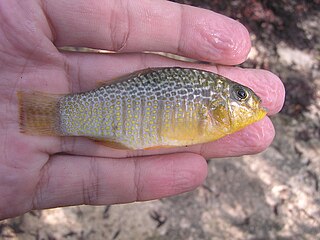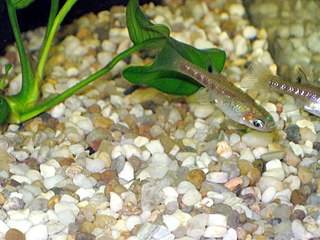
The Ash Meadows killifish is a species of killifish from the subfamily Empetrichthyinae, part of the family Goodeidae, which was first documented by C. H. Gilbert in 1893 and historically occupied numerous springs near Ash Meadows, Nye County, Nevada, United States. This species was last seen in 1948 and is believed to have gone extinct in the early 1950s, likely as a result of habitat alteration and competition with and predation by introduced crayfish Procambarus clarkii, mosquitofish, black mollies, and bullfrogs.
The sabrefin killifish, also known as the Santa Catarina sabrefin or Turner's gaucho, is a species of killifish in the family Rivulidae. It is endemic to Brazil. This species was described in 1974 with the type locality being a temporary pool between Criciuma and Tubarão in Santa Clara state. The specific name honours the American ichthyologist, geneticist and ecologist Bruce J. Turner.
Campellolebias is a genus of killifish in the family Rivulidae from southeast Brazil. They are restricted to seasonal blackwater pools in forests in coastal parts of Santa Catarina and São Paulo states.
Nothobranchius foerschi is a species of killifish in the family Nothobranchiidae. It is endemic to Tanzania. Its natural habitat is probably temporary pools. The specific name honours the German physician and aquaris Walter Foersch (1932-1993), who was an expert in killifish and was one of the first people to keep and breed this species.
Nothobranchius steinforti is a species of killifish in the family Nothobranchiidae. It is endemic to Upper Wami River drainage, Tanzania. Its natural habitat is intermittent freshwater marshes, pools and rice fields. This species was described in 1977 by Rudolf Hans Wildekamp with the type locality given as "8 kilometers from Kimamba, Tanzania". The specific name honours the Dutch aquarist Theo Steinfort who helped collect the type and bred this species in captivity, making it available to other killifish hobbyists.
The Ceylon killifish (Aplocheilus dayi) is a species of killifish endemic to Sri Lanka. This species grows to a length of 9 cm (3.5 in). Males and females have a black dot at the rear end of the base of the dorsal fin. The females lay 50–150 eggs. The specific name of this fish honours the Inspector-General of Fisheries in India Francis Day (1829-1889), who first reported this fish, although he identified it as Aplocheilus panchax.

Floridichthys is a genus of pupfishes native to the southeastern United States, Mexico and northern Central America. The name of this genus is a compound of Florida and the Greek for "fish", ichthys. The ichthyologist Carl Leavitt Hubbs thought that the genus was confined to Florida at the time he coined the name.

Girardinus is a genus of poeciliids native to Cuba. The name of this genus honours the French zoologist Charles Frédéric Girard (1822-1895) for his work on the freshwater fish of North America.
The Mexican rivulus is a species of killifish from the family Rivulidae which is endemic to Mexico where it is found in the Papaloapan and Coatzacoalcos River basins. This annual killifish grows to a total length of 4 cm (1.6 in). It is the only known species in its genus, but its exact taxonomic position remains uncertain, as it has not been included in any phylogenetic study. This species was described by Robert Rush Miller and Carl Leavitt Hubbs as Rivulus robustus in 1974, it was reclassified in the monotypic genus Millerichthys in 1995, the generic name honouring Robert Rush Miller.
Rachovia is a genus of killifish from the family Rivulidae the species of which are endemic to the Orinoco, Maracaibo and Magdalena basins in Colombia and Venezuela, where they live in small temporary waters like ponds. They are small annual killifish that reach up to 6 cm (2.4 in) in total length. The name of this genus honours the German aquarist Arthur Rachow (1884-1960) who sent fish specimens to George S. Myers.
Renova oscari is a species of killifish from the family Rivulidae which is endemic to the Orinoco River basin of Venezuela. This annual killifish grows to a standard length of 4.7 cm (1.9 in). This species is the only known member of its genus. It is found in the aquarium trade. This species was described in 1995 by Jamie E. Thomerson and Donald Charles Taphorn Baechle with the type locality given as the southwestern edge of Isla Raton in the vicinity of the village of Sabanita, upper Río Orinoco. The specific name honours Oscar León Mata (1964-2018), a killifish collector, environmental engineer and curator of fish at Museo de Ciencias Naturales in Guanare.

The emerald aphyosemion is a species of killifish, endemic to the lower Cross River basin in Nigeria. It is a coastal rainforest fish which lives in small streams and ponds. It prefers a temperature of around 75 °F (24 °C), and a slightly acidic pH around 6–7. The specific name honours the Danish count, army colonel, explorer and ichthyologist Jørgen J. Scheel (1916–1989).

Mucurilebias leitaoi is a species of rivulid killifish endemic to Brazil where it occurs, or formerly occurred, in the basin of the Mucuri River. This species can reach a length of 3 centimetres (1.2 in) TL. This species has not been seen since the original series of types was collected in 1988 and it may have become extinct due to the extensive habitat loss in the region. This species is the only known member of its genus, but it was formerly included in Leptolebias. The specific name of this fish honours the Brazilian ichthyologist and herpetologist Antenor Leitão de Carvalho (1910-1985).
The Dead Sea toothcarp is a subspecies of the Arabian toothcarp that is endemic to the Dead Sea basin, although molecular evidence suggests that it should be regarded as a species. It is threatened by water fluctuation, and the introduction of cichlids and Gambusia. The sub-specific name of this fish honours the Scottish surgeon and naturalist John Richardson (naturalist) (1787-1865) who first reported killifish in the Dead Sea basin.

Simpsonichthys constanciae is a species of killifish from the family Rivulidae that is endemic to Brazil. It is restricted to temporary freshwater habitats in the São João basin in Rio de Janeiro, while all other species in the genus are from Bahia. It is a small killifish that is up to 6 cm (2.4 in) in total length. The specific name of this fish honours Constance White, an American watercolour painter, who collected type of this fish with her husband, Lieutenant colonel Thomas D. White, and created colour sketches for George S. Myers.
Aplocheilus werneri is a species of killifish endemic to Sri Lanka. This species grows to a length of 7 cm (2.8 in). Its natural habitats are small, shallow, slow-flowing, heavily shaded streams and rivulets with a silt or clay substrate. They are largely use as an aquarium fish. The specific name honours the fish importer Andreas Werner whi imported this species into Germany for the first time in 1964.

Tlaloc is a genus of fish in the family Profundulidae endemic to Mexico, Guatemala and Honduras. The genus is not, however, recognised by Fishbase or in the 5th Edition of Fishes of the World. The genus is named for Tlaloc the water god of the Aztecs.

The Seminole killifish is a fish of the genus Fundulus, endemic to the U.S. state of Florida.
Cubanichthys pengelleyi, the Jamaican killifish, is a species of killifish from the family Cyprinodontidae, the pupfishes, which is endemic to Jamaica. It is found in shallow, crystal clear waters with a depth of 1.5 metres (4.9 ft) and a pH of 8.2). These have a substrate consisting mainly of sand with some softer patches of silt. This species hides among aquatic vegetation. Its prey consists of damselfly and dragonfly larvae, the larvae of other aquatic insects, ostracods, copepods and snails. The specific name honours the Jamaican physician and medical officer Charles Edward Pengelley (1888–1966) who obtained the type.
Aapticheilichthys is a monotypic genus of killifish from the family Poeciliidae, the sole member being Aapticheilichthys websteri. A. websteri was found by the American fish breeder Kent Webster after which the species was named. The type locality was Akaka Camp on the western coastal plain of Gabon.








